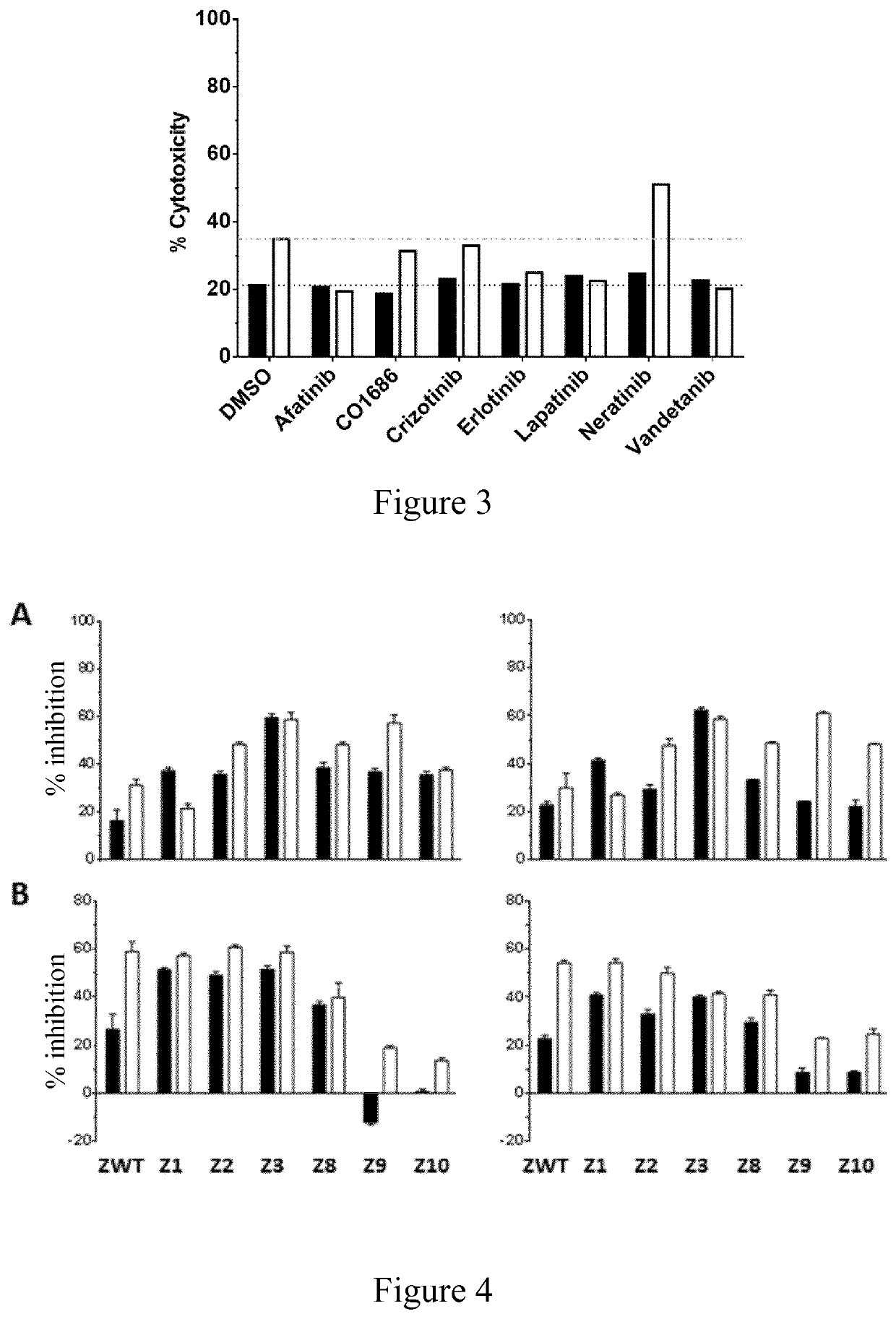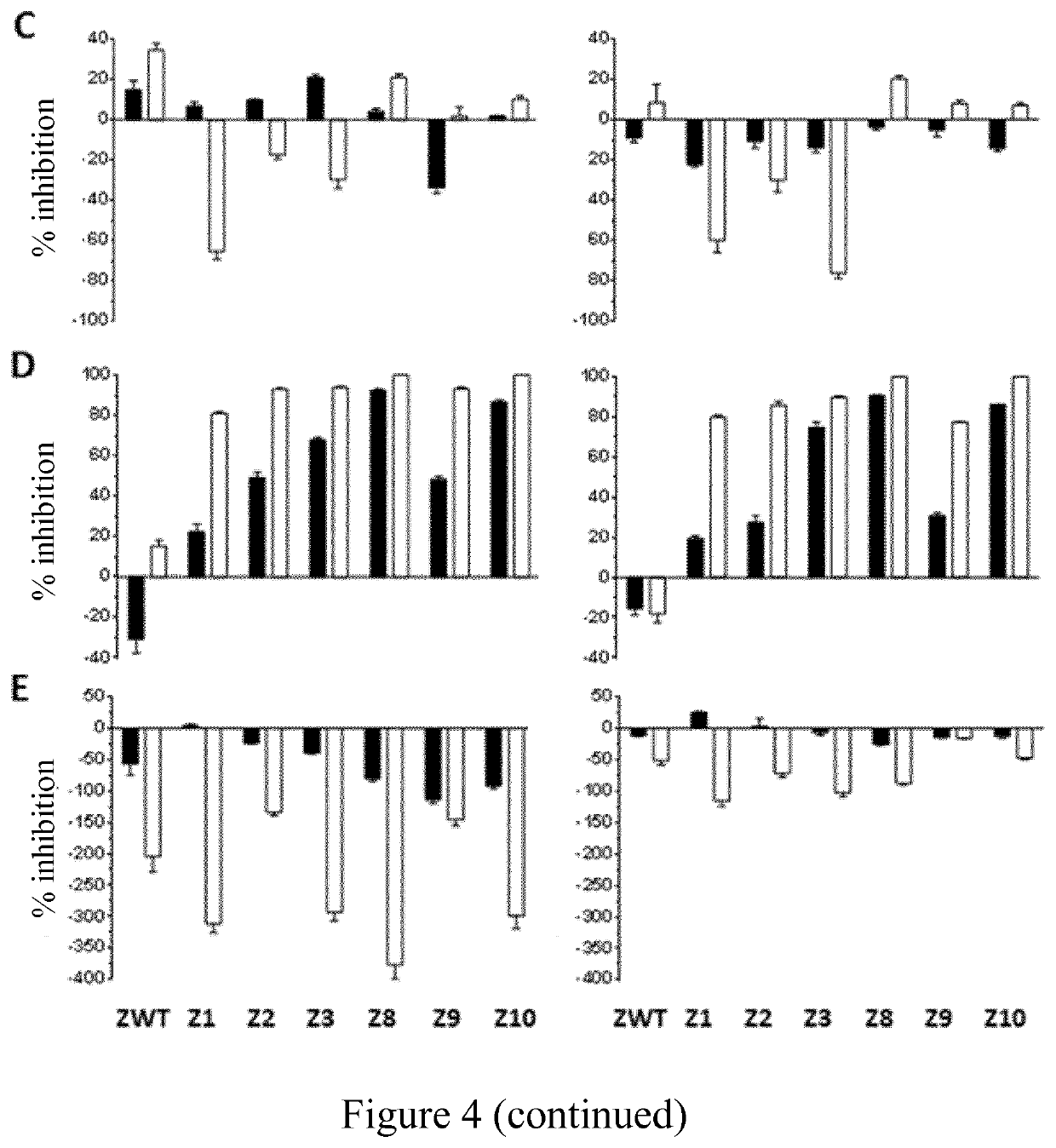Kinase mutants and uses thereof
a technology of kinase mutants and kinase proteins, applied in the field of gene therapy, can solve the problems of affecting the immune system, affecting the function of the immune system, and affecting the adme profile of undesirable ligands,
- Summary
- Abstract
- Description
- Claims
- Application Information
AI Technical Summary
Benefits of technology
Problems solved by technology
Method used
Image
Examples
example 1
of Kinase Inhibitors for use in Kinase Engineering
[0253]Different kinase inhibitors that are FDA-approved or are advanced in clinical trials can be used in a method of design of kinase mutants according to the invention. For example, the kinase ligand can be selected according to the following criteria:[0254]agent which is FDA-approved or advanced in clinical trials, ensuring its possible use in human;[0255]agent having little or no affinity for the wild-type target kinase (e.g. for ZAP-70 and / or Lck), ensuring that non-reprogrammed cells will not be affected by them;[0256]agent having little cross-reactivity with other kinases than the foreign kinase (other than the target kinase), and limited known side effects;[0257]agent having available experimentally determined binding mode to the foreign kinase they target, to ensure that this binding mode is compatible with a binding in the active site of the kinase to be mutated, i.e. to ensure that no large conformational change of the rep...
example 2
d Characterization of Binding of Kinase Mutants
[0263]Several mutants of Zap-70 and Lck were designed according to the method of the invention and the binding free energy change for their binding to selected compounds was calculated.
[0264]Docking of Selected Kinase Inhibitors in Zap-70 and Lck
[0265]Kinase inhibitors selected after second step in Example 1 (step b) of the method of the invention for designing a kinase mutant) i.e. Afatinib, Erlotinib, Lapatinib, Neratinib, Vandetanib and Gefitinib were docked into the experimental 3D structure of Zap-70 and Lck, using the PDB files 1U59 and 3AD5, respectively. This allows verifying that the calculated binding mode, i.e. the position, conformation and orientation, of the ligand into the wild-type kinase, e.g. Zap-70 or Lck active sites is similar to the one observed experimentally for these kinase inhibitors in their respective primary target kinases, despite the lower affinity. This ensures that these small molecules have the potentia...
example 3
n of Kinase Mutants in T Cells
[0287]The expression profile of kinase mutants in T cells can be tested as follows, in particular Zap-70 mutants were tested to assess the expression of those mutants in this cell type.
[0288]Cell Line
[0289]The P116 T cell line deficient for Syk and Zap-70 was purchased from ATCC (Manassas, Va.) and were maintained in complete media (Roswell Park Memorial Institute (RPMI)-1640 medium supplemented with 10% heat-inactivated fetal bovine serum and penicillin-streptomycin, all from Gibco, Invitrogen).
[0290]Lentivirus Production and Cell Transduction Efficiency
[0291]Full-length codon optimized DNA encoding the Zap-70 mutants were cloned in the pRRL third generation lentiviral vector (Dull et al., 1998, J. Virol., 72: 8463-8471). Lentiviral vectors were produced by transient transfection of 293T cells using a standardized protocol for Lipofectamine 3000 (ThermoFisher Scientific). The P116 cells were transduced with fresh lentiviral supernatant and expression o...
PUM
| Property | Measurement | Unit |
|---|---|---|
| nucleic acid | aaaaa | aaaaa |
| affinity | aaaaa | aaaaa |
| binding affinity | aaaaa | aaaaa |
Abstract
Description
Claims
Application Information
 Login to View More
Login to View More - R&D
- Intellectual Property
- Life Sciences
- Materials
- Tech Scout
- Unparalleled Data Quality
- Higher Quality Content
- 60% Fewer Hallucinations
Browse by: Latest US Patents, China's latest patents, Technical Efficacy Thesaurus, Application Domain, Technology Topic, Popular Technical Reports.
© 2025 PatSnap. All rights reserved.Legal|Privacy policy|Modern Slavery Act Transparency Statement|Sitemap|About US| Contact US: help@patsnap.com



